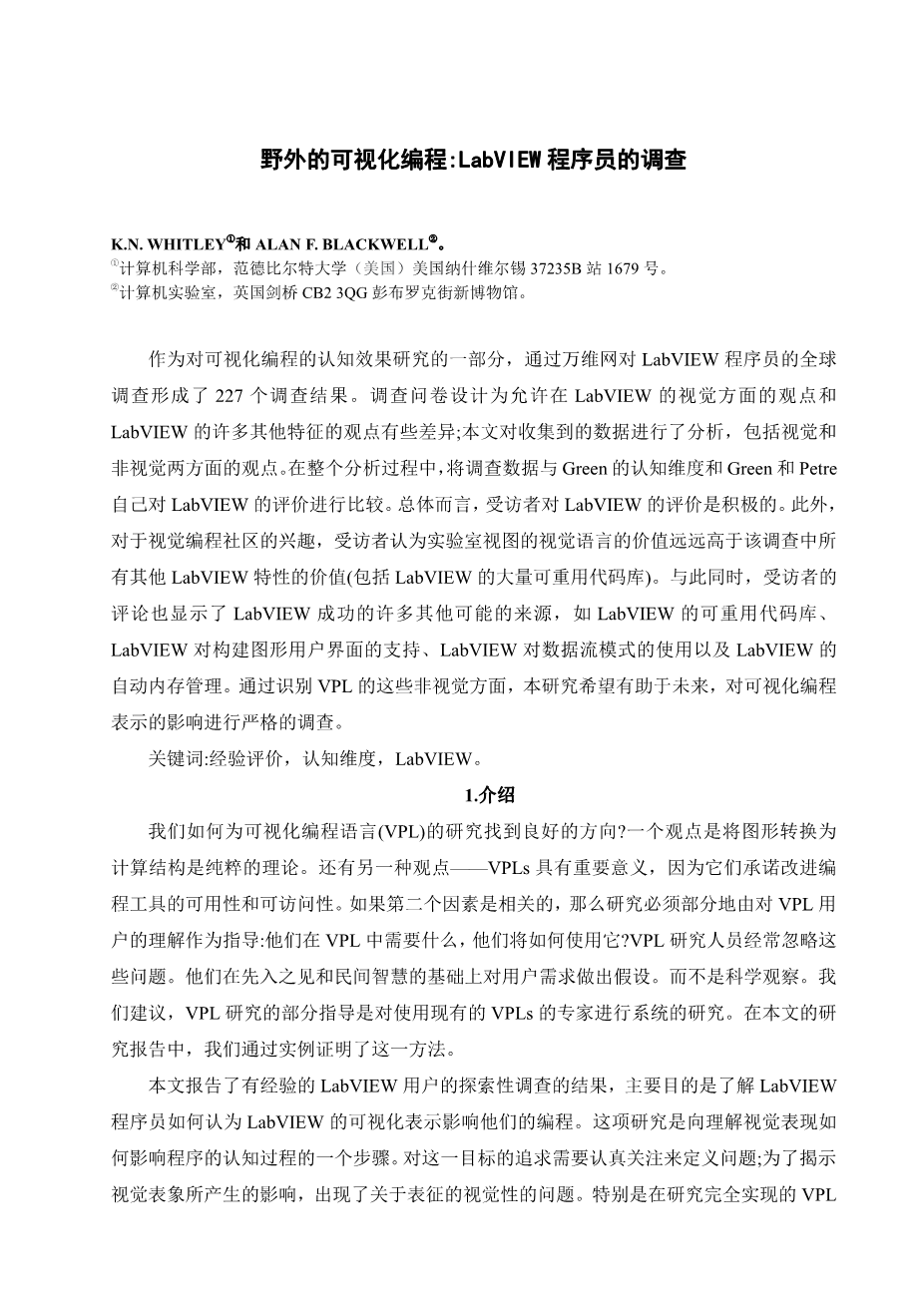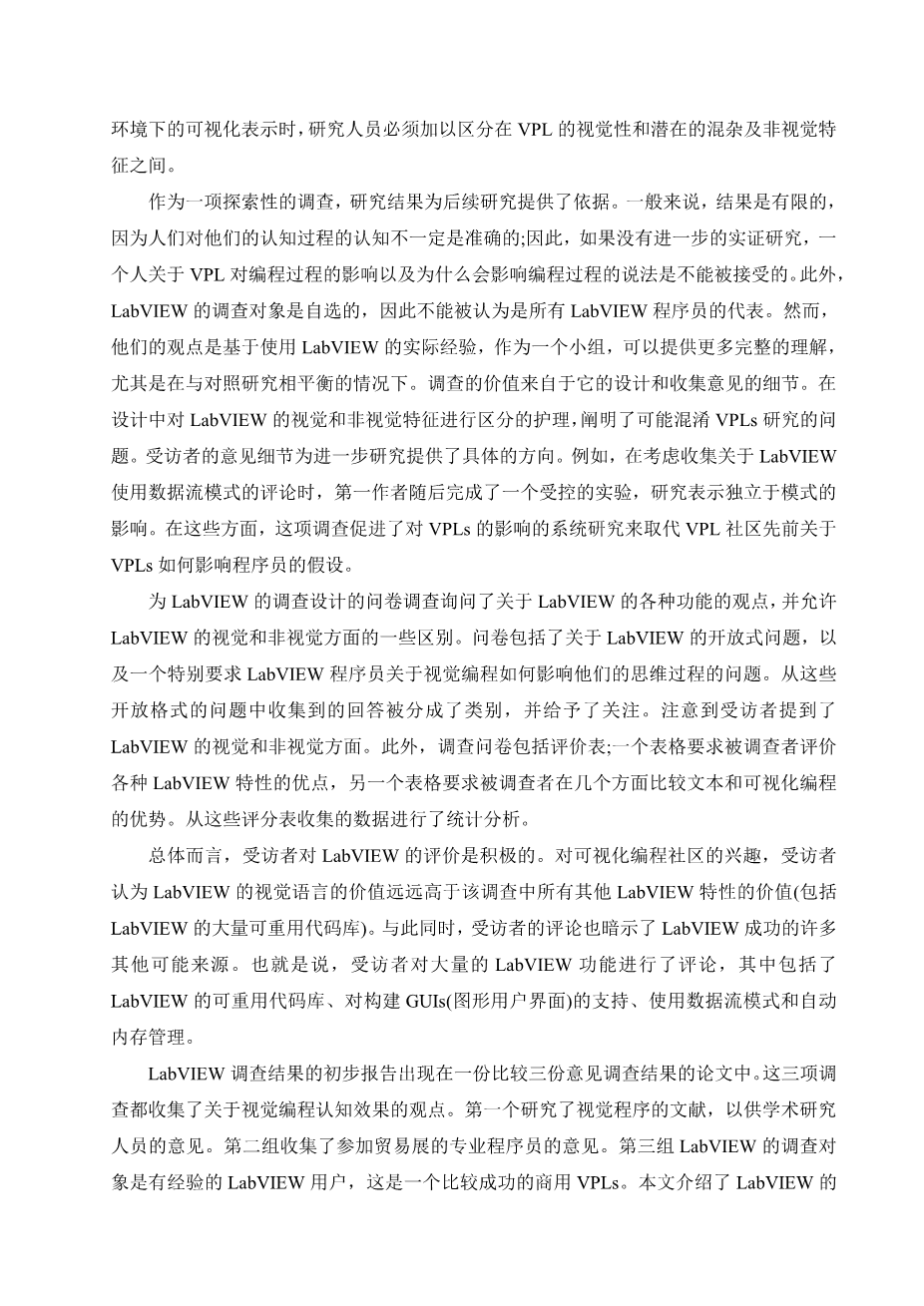Visual Programming in the Wild:
A Survey of LabVIEW Programmers
K. N. W HITLEY ① AND A LAN F. B LACKWELL ②
①Department of Computer Science, Vanderbilt University, Box 1679, Station B, Nashville,TN 37235, U.S.A., ②Computer Laboratory, New Museums Site,Pembroke Street, Cambridge CB2 3QG, U.K., e-mail: alan.blackwell@cl.cam.ac.uk
As part of research into the cognitive effects of visual programming representations, a worldwide survey of LabVIEW programmers was conducted via the World Wide Web and resulted in 227 survey responses. The survey questionnaire was designed to allow some distinction between opinions about the visual aspects of LabVIEW and opinions about LabVIEW’s many other features; this paper presents an analysis of this collected data, including both the opinions of the visual and non-visual aspects. Throughout the analysis, comparisons are made from the survey data both to Green’s cognitive dimensions and to Green and Petre’s own assessment of LabVIEW [1, 2]. Overall, the respondents were positive in their assessment of LabVIEW. Moreover, of interest to the visual programming community, respondents rated the value of LabVIEW’s visual language significantly higher than the value of all other LabVIEW features rated in this survey (including LabVIEW’s extensive libraries of reusable code). At the same time, respondents’ comments suggest many other possible sources of LabVIEW’s success such as LabVIEW’s libraries of reusable code, LabVIEW’s support for building GUIs, LabVIEW’s use of the dataflow paradigm and LabVIEW’s automatic memory management. By identifying these non-visual aspects of a VPL, this research hopes to contribute to future, rigorous investigation of the impact of visual programming representations.( 2001 Academic Press)
Keywords: empirical evaluation, cognitive dimensions, LabVIEW.
1. Introduction
HOW CAN WE FIND good directions for visual programming language (VPL) research? One perspective is that transforming graphics into computational structures is interesting as pure theory. There is an alternative perspective}that VPLs are significant because they promise improvements in the usability and accessibility of programming tools. If the second factor is relevant, research must be directed in part by an understanding of
VPL users: what do they need in a VPL and how would they use it? VPL researchers have often neglected this issue. They make assumptions about user requirements based on preconceptions and folk wisdom, rather than scientific observation [3]. We propose that VPL research be partly directed by methodical study of skilled users who are experts in the use of existing VPLs. In the research reported in this paper, we demonstrate this approach by example.
This paper reports the results of an exploratory survey of experienced LabVIEW users, a main goal being to learn how LabVIEW programmers think that the visual representation of LabVIEW affects their programming. This research is a step towards understanding how visual representation impacts the cognitive processes of programmers. Pursuit of this goal requires careful attention to definitional issues; in order to uncover effects accruing from a visual representation, questions arise about what constitutes the visualness of the representation. Particularly when studying visual representation in the context of a fully implemented VPL, a researcher must distinguish between the visualness of the VPL and its potentially confounding, non-visual features.
As an exploratory survey, the results presented herein provide grist for subsequent research. In general, the results are limited in that people’s perceptions of their cognitive processes are not necessarily accurate; thus, a person’s claims as to how and why a VPL impacts the programming process cannot be accepted as fact without further empirical study. Moreover, the LabVIEW survey respondents were self-selected and, so, cannot be assumed to be representative of all LabVIEW programmers.However,their opinions are based on real experience using LabVIEW and, as a group, can provide a more complete understanding, especially if balanced with controlled studies. The value of the survey stems from both its design and details of the collected opinions.The care taken in its design to distinguish between the visual and non-visual features of LabVIEW illuminates the issues that can potentially confound studies of VPLs. The details of the respondents’ opinions provide specific directions for further research. For example, in considering the collected comments about LabVIEW’s use of the dataflow paradigm, the first author has subsequently completed a controlled experiment investigating the effects of representation independent of paradigm [4]. In these ways, this survey promotes the methodical study of the effects of VPLs in order to replace the VPL community’s prior assumptions about how VPLs affect programmers.
The questionnaire designed for the LabVIEW survey asked for opinions about a wide range of LabVIEW features and allowed some discrimination between LabVIEW’s visual and non-visual aspects. The questionnaire included open-format questions about LabVIEW as a whole and one question that specifically asked LabVIEW programmers about how visual programming affects their thought processes. The responses collected from these open-format questions have been grouped into categories, with care given to noting when the respondents referred to visual versus non-visual aspects of LabVIEW. Additionally, the questionnaire included ratings tables; one table requested respondents to rate the advantages of various LabVIEW features, while another asked respondents to compare the advantages of textual and visual programming along several dimensions. The data collected from these ratings tables have been statistically anal
剩余内容已隐藏,支付完成后下载完整资料


英语译文共 8 页,剩余内容已隐藏,支付完成后下载完整资料
资料编号:[478578],资料为PDF文档或Word文档,PDF文档可免费转换为Word


